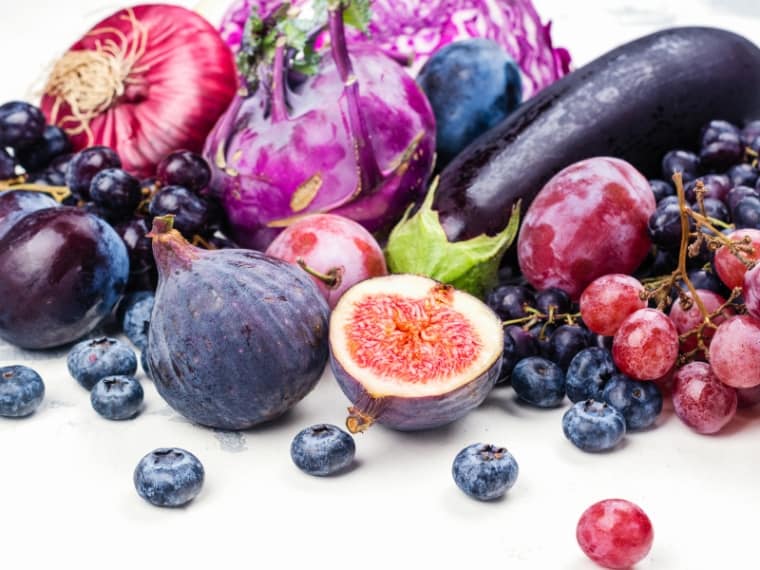Purple fruits are delicious but also bring a lot of health benefits due to their high vitamin and mineral content.
What’s more, all purple fruits are rich in powerful antioxidants called anthocyanins. These give the fruit its purple color.
Let’s see what makes purple fruits so special.
Are Purple Fruits Healthy?
The color of the fruits is given by the type of pigments or nutrients they contain. For example, the purple color of the fruits is due to the high anthocyanin content.
Purple fruits are rich in anthocyanins. They are used as a natural food colorant and have potential health benefits due to their powerful antioxidant properties. Moreover, these antioxidants help fight free radicals.
Purple fruits are incredibly healthy and nutritious due to their high anthocyanin content. These antioxidants help improve visual and cardiovascular health. They are also said to have an anti-cancer effect by suppressing cell proliferation and inhibiting cell invasion.
Furthermore, purple fruits may also help in the fight against diabetes through the effect of anthocyanins in alleviating hyperglycemia and insulin sensitivity.
Moreover, purple foods can also suppress weight gain and help relieve obesity.
So, apart from being delicious, purple fruits are also nutritious and obviously healthy.
Consuming fresh purple fruits is recommended, as the antioxidants can be destroyed once heat is applied.
Note: Please keep in mind that the material in this article is not intended to be a substitute for professional medical advice. Consult your doctor and adhere to his or her instructions before attempting any treatment.
Why Are There So Few Purple Foods?
Although healthy, purple foods are pretty rare. That’s because there are very few purple things in nature. But why? The pigment type that purple foods contain is often masked by other pigments, such as chlorophyll (green) or carotenoids (yellow, orange, and red).
Additionally, factors like pH, light, and temperature impact the stability of anthocyanin pigments, which can further restrict their presence in foods.
Although this pigment is attributed to purple fruit, it can also appear in blue, black, or red fruit.
The color of fruits rich in anthocyanins can vary from blue to purple depending on the pH of the fruit’s cells. In acidic environments, the anthocyanins appear red, while in more basic environments, they appear blue.
This means that fruits with a more acidic pH, such as blueberries and blackberries, tend to have a more blue color. In contrast, those with a less acidic pH, such as grapes and cherries, tend to have a more purple color.
The health benefits of purple foods are often attributed to the presence of anthocyanins, which have been linked to various positive health effects, including antioxidant and anti-inflammatory properties.
Moreover, the more anthocyanins the fruit contains, the more purple it is.
14 Purple Fruits
1. Blackberry

Blackberries are a superfood since they are high in antioxidants and a strong source of fiber. They are also high in vitamins and minerals, such as vitamin C, vitamin K, potassium, magnesium, and lutein.
Blackberries may reduce the risk of inflammation and degenerative diseases such as cardiovascular disease, obesity, diabetes, and osteoporosis.
According to a study, blackberries can also destroy breast tumors and cancer cells. [1]
Interestingly, when it comes to anthocyanins, the darker the fruit, the higher the level of antioxidants.
2. Purple Grapes
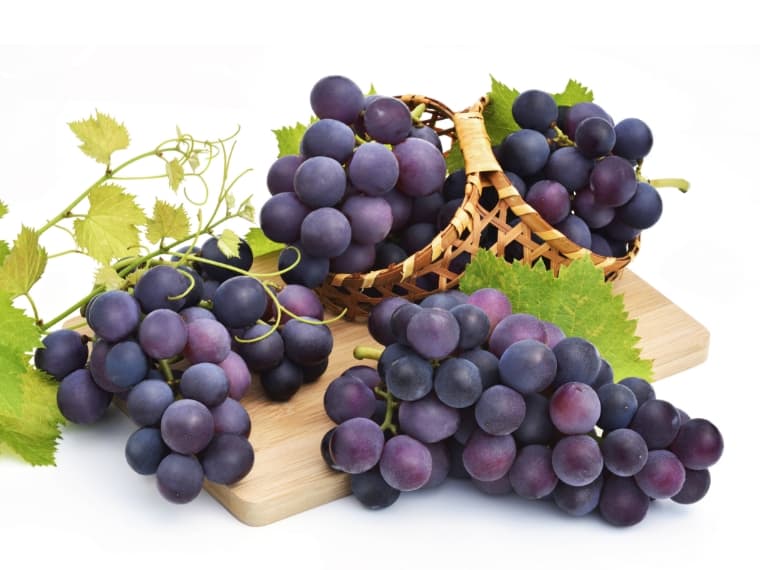
As with blackberries, purple grapes are richer in antioxidants the darker they are. That’s why people refer to them as black grapes.
Purple grapes are the healthiest grapes because their antioxidants help protect your cells from damage. They also help fight against several diseases like Alzheimer’s and Parkinson’s, as well as many heart diseases, diabetes, and even cancer cells.
That’s why purple grapes are better than other varieties. They are a true superfood.
There are many varieties of purple grapes, and among the most popular are Concord grapes, native to Concord, Massachusetts. Other purple grape varieties include Autumn Royal, Moon Drop, and Black Monukka.
3. Passion Fruit
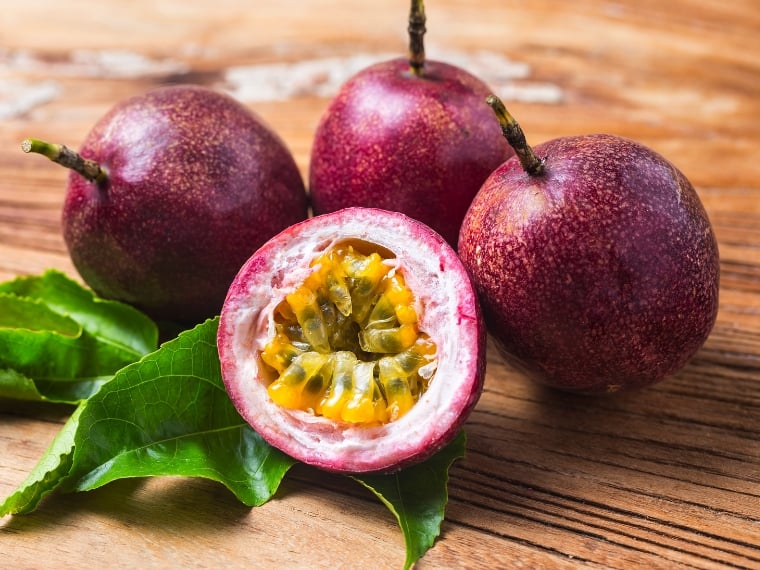
Passion fruit is a tropical fruit of the Passiflora vine, rich in vitamins A and C. Moreover, this delicious and healthy fruit is full of iron, which helps improve the body’s absorption of vitamin C.
In addition, passion fruit also contains niacin, phosphorus, and vitamin B6.
It is also believed that it helps relieve osteoporosis symptoms. Furthermore, it is said to help improve respiratory conditions.
Thus, this is a superfood because it is rich in antioxidants, has a low glycemic index, and is an excellent source of fiber. Additionally, its dietary fiber content may help reduce cholesterol. [2]
In addition to these benefits, passion fruit:
- Improves the immune system
- Protects heart health
- Magnesium content may help reduce anxiety [3]
4. European Plum
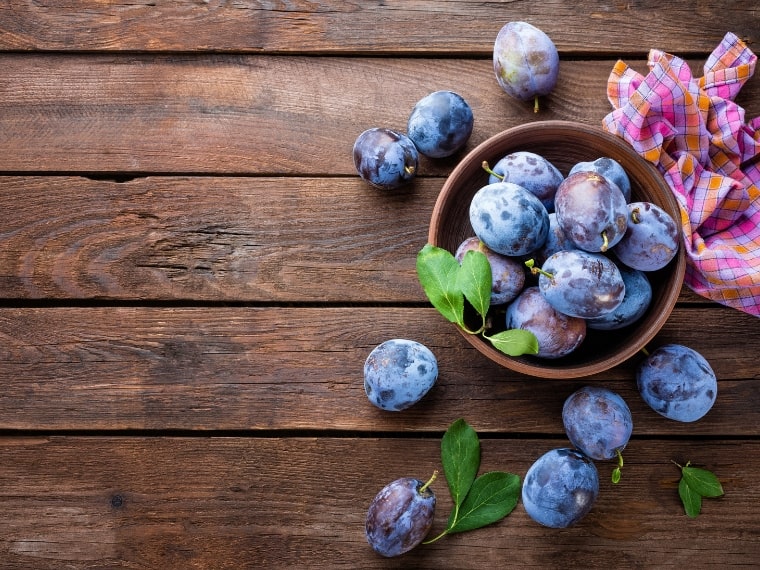
Plums are rich in polyphenols or phenolic compounds. These offer protection against diabetes, cardiovascular, and neurodegenerative diseases. [4]
Plums are rich in vitamin C, vitamin B2, and vitamin A. Vitamin B2 helps improve digestion, while vitamin A helps bone health. Last, vitamin C enhances iron absorption and boosts the body’s immunity.
The most popular European varieties of purple plums include Damson, Moyer, and French prune.
Damson plum is a European variety with dark purple skin and tart-flavored flesh. Moreover, this is slightly acidic and tastes a bit bitter.
Moyer plums are probably the best European plum variety. They are very sweet, which is why they are also called sugar plums.
French prune is another European variety often used as dried to make prunes. They have smokey skin in shades of purple, and their flesh is dark amber.
But there are also other varieties. For example, the Black Beauty plum is a Japanese variety. These plums have bright yellow flesh and dark purple skin. Moreover, they are extremely juicy.
European plums can be used to make jams, chutneys, puddings, porridge, tarts, or smoothies.
5. Purple Mangosteen
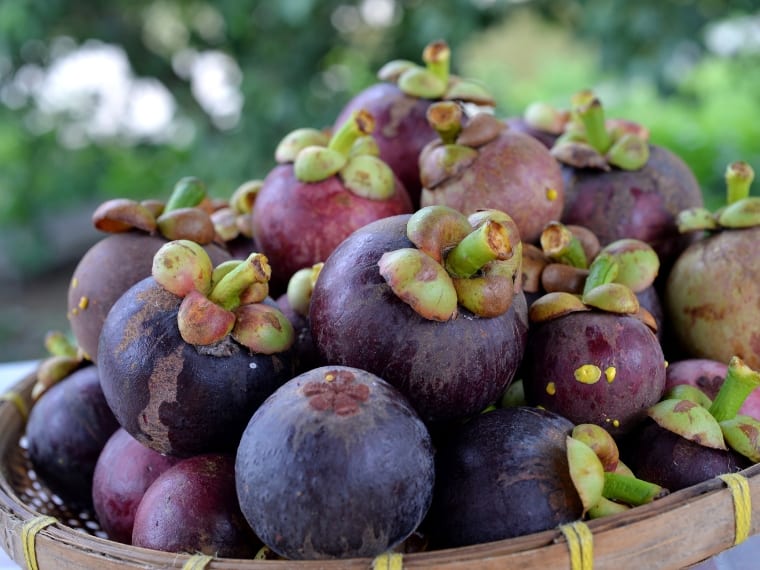
Purple mangosteen is a tropical fruit that is not only delicious but also has various health benefits.
Purple mangosteen contains natural compounds called xanthones, which have been shown to have anti-bacterial and anti-inflammatory properties. This means that it may help reduce inflammation in the body and potentially prevent chronic diseases such as heart disease and cancer. [5]
Some studies suggest that the xanthones found in purple mangosteen may have anti-cancer properties. [6]
Furthermore, mangosteen’s high vitamin C content may help boost your immune system. Mangosteen also contains folates which can improve DNA and red blood cell production. [7]
In addition, purple mangosteen is low in calories and high in fiber, making it an ideal fruit for weight loss. It is also rich in vitamins C and B6 and minerals such as potassium and magnesium.
6. Blackcurrant
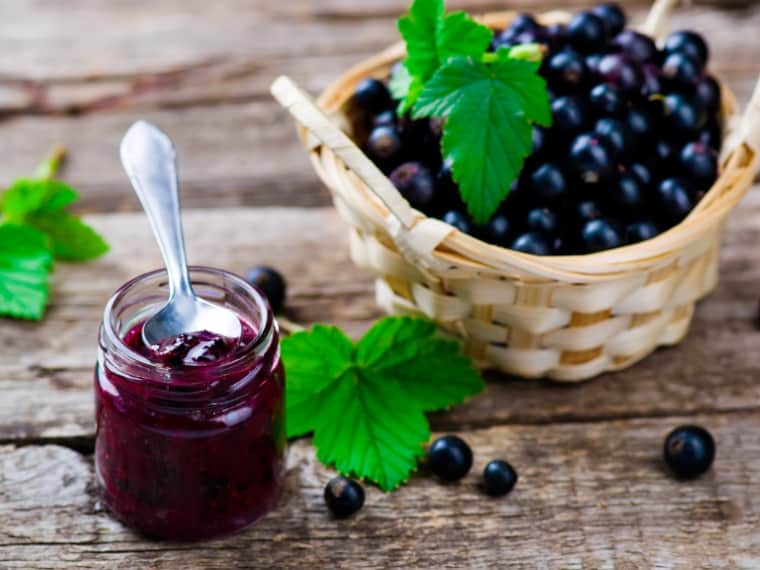
Blackcurrants are among the most prized berries because they are rich in vitamins, minerals, and other compounds beneficial to health. They have a sour taste and can be used in making jams, jellies, compotes, and other delicious recipes.
Blackcurrants are delicious and nutritious purple fruits rich in polyphenols, especially phenolic acid derivatives, anthocyanins, and flavonols. According to research, anti-cancer activity and phenolic component content are related. [8]
Furthermore, blackcurrants are one of the richest sources of vitamin C, providing over three times the recommended daily intake in just one serving.
Blackcurrants are also high in anthocyanins and other helpful nutrients for your eyes. These nutrients aid in the prevention of age-related macular degeneration and other vision issues.
Blackcurrant anthocyanins may also assist in improving circulation by promoting blood vessels’ dilatation, which can lower the risk of cardiovascular disease.
7. Java Plum
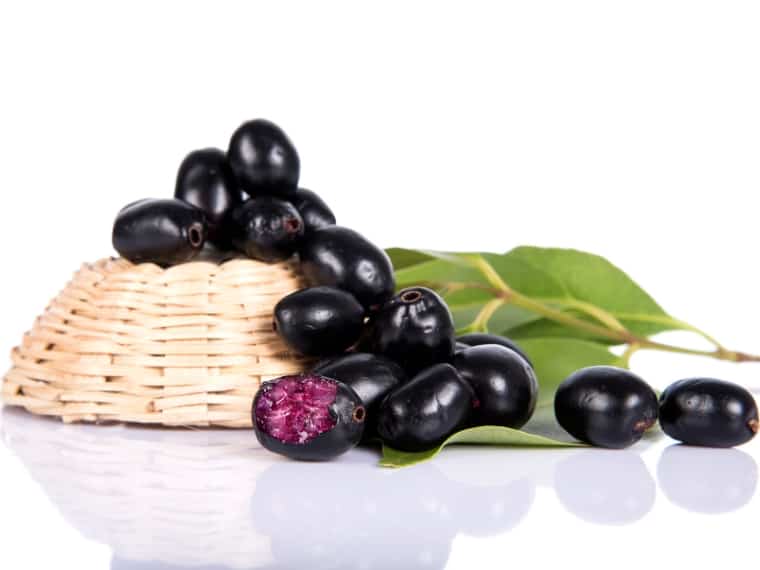
Java plums, also known as Jambul or Indian plums, are smaller than European plums and have a slightly tangy flavor that is often described as sweet and sour.
Java plum is rich in vitamin C and zinc; this combo can help prevent coughing and other respiratory complications. What’s more, it can help relieve asthmatic symptoms.
Their seeds may also help treat diarrhea.
Interestingly, in the case of ripe Java plums, their peel has 20 times more antioxidants than the flesh.
8. Purple Star Apple
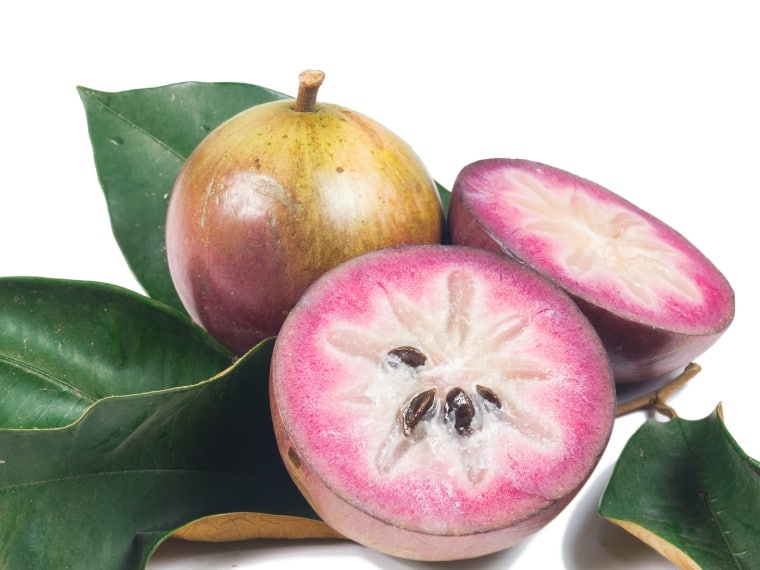
Purple star apple is a tropical fruit native to Central and South America. This round-shaped fruit has a purple, star-shaped interior when cut open. Its flesh is white, juicy, and has a sweet, mildly tangy flavor.
Like many fruits, it goes through three colors throughout the ripening process: red, green, and purple.
Purple star apple is a good source of fiber, vitamin C, and antioxidants. It may also have potential health benefits, such as reducing inflammation and improving heart health.
Besides fighting free radicals, they are rich in calcium and potassium. As a result, they help to improve bone health.
Also, the vitamin C found in them helps prevent iron deficiency by increasing the rate of iron absorption.
Moreover, it’s a tasty and nutritious addition to your diet. However, it’s important to consume this fruit in moderation, as it contains natural sugars and can be high in calories.
9. Acai Berry
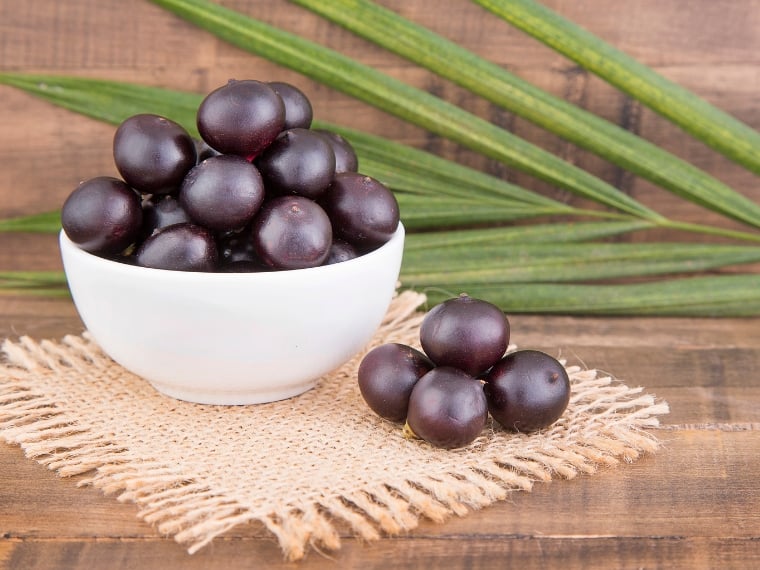
Acai berries are small, dark purple berries native to Brazil that grow in the tropical rainforests of South America. These fruits grow in the acai palm tree and are consumed as juice, shakes, or smoothies.
Acai berries are high in fiber, healthy fats, and a variety of vitamins and minerals, such as vitamin A, calcium, and potassium.
They are also rich in anthocyanins and other antioxidants, which can protect the body from oxidative stress and inflammation.
Moreover, they have many health benefits, including improving cholesterol levels, reducing inflammation, and supporting brain function.
In Brazil, acai bowls are a popular dish. It has a base of various berries and toppings of granola and other fruits.
10. Red Dragon Fruit
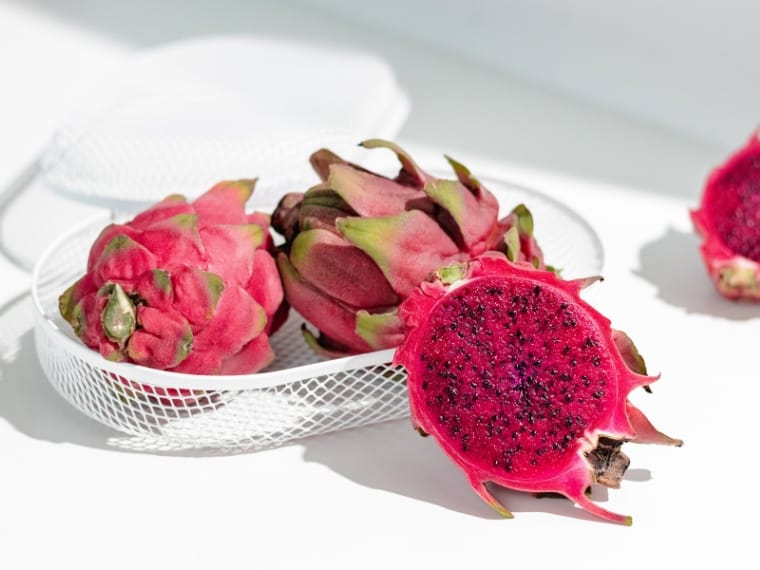
Red dragon is a tropical fruit rich in vitamin C, antioxidants, and minerals such as iron, magnesium, and calcium. This oval-shaped fruit is native to Central and South America.
It has bright pink or red skin, green scales, and a red fleshy interior filled with black seeds. Red dragons have a mildly sweet flavor, often compared to a cross between kiwi and pear.
The purplish-red color of the fruit comes from natural pigments called betacyanins, which have antioxidant properties that may help protect your cells from free radical damage.
Red dragon fruit also has a low glycemic index. This means it may help regulate blood sugar levels and be a good fruit option for people with diabetes.
Other potential health benefits of red dragon fruit include improved digestion, reduced inflammation, and improved blood sugar control.
According to one study, dragon fruit extract can stop the growth of breast cancer cells. [9]
You can add red dragons to a healthy diet in the form of smoothies or fruit salad. You can also use these fruits in recipes such as cheesecakes or puddings.
11. Saskatoon Berry
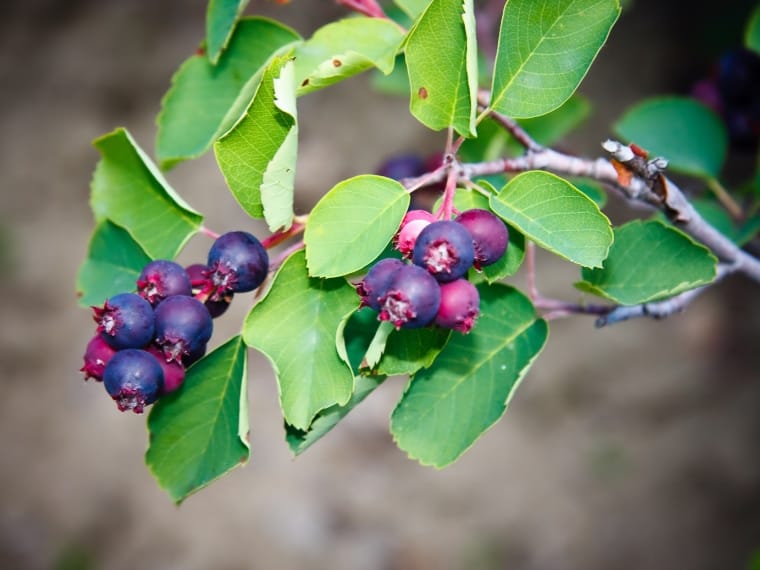
Saskatoon berries are small berries that grow on shrubs native to Canada and parts of the United States. These berries have a slightly sweet, nutty flavor with a hint of almond and can be eaten raw or used in baking, jams, and sauces.
Depending on the region, this type of berry is also known as serviceberry, Juneberry, or shadbush.
Saskatoon berries are small and dark purple berries. They are smaller compared to blueberries.
These berries are a good source of fiber, vitamin C, and antioxidants. The fruit has a slightly sweet, nutty flavor with a hint of almond and can be eaten raw or used in baking, jams, and sauces.
They are high in phenolic compounds such as anthocyanins, proanthocyanins, and quercetin.
As a result, this delicious berry has numerous health benefits, including antioxidant and antiradical properties. Moreover, Saskatoon berry has anti-inflammatory, antidiabetic, vessel-protecting, and neuroprotective properties. [10]
12. Elderberry
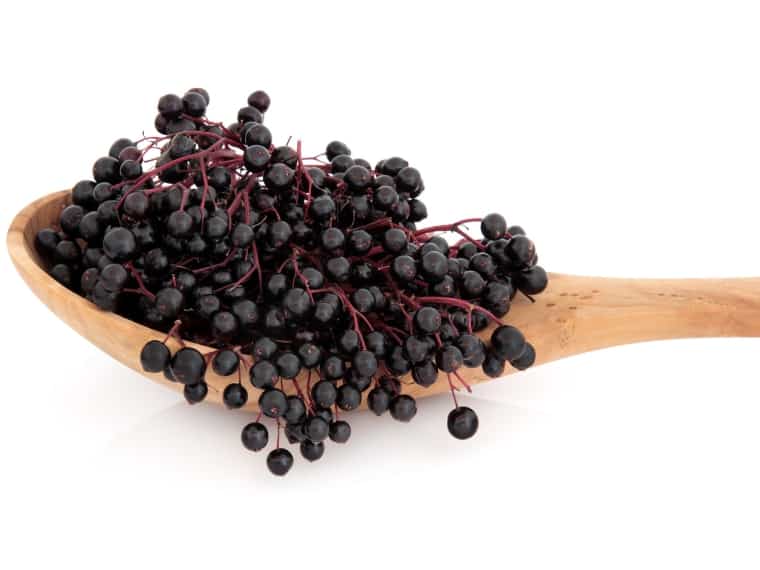
The dark purple berry of the European or black elder tree is called elderberry.
Elderberry berries are high in antioxidants and vitamins, which may help your immune system. Furthermore, they are one of the world’s most widely used medicinal plants.
Interestingly, elderberry has been used in traditional medicine as a supplement to treat flu symptoms.
However, raw unripe elderberries and other parts of the elder tree, including the leaves and stem, contain toxins. Only cooking removes this toxin.
13. Indigo Rose Tomato
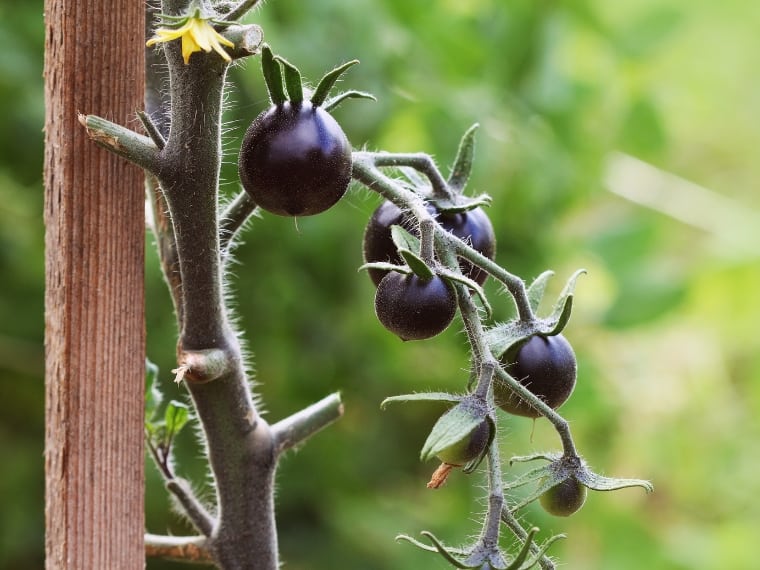
Purple tomatoes? Yes, purple tomatoes are edible.
Indigo rose is a dark purple-skinned tomato variety with a flavor similar to plums. Moreover, indigo rose tomatoes have a mildly sweet, smokey flavor and are incredibly juicy.
Curious about what makes them unique from other varieties? Purple tomatoes are healthier than other varieties because they are high in anthocyanins. As previously said, they are powerful antioxidants with numerous health benefits.
14. Figs

Figs are full of nutrients that can help support digestion, manage blood sugar levels, and reduce the risk of heart disease.
Figs are also rich in vitamin K, necessary for producing prothrombin, a protein and an essential factor in blood clotting and bone metabolism.
According to a study of 150 people with irritable bowel syndrome, eating 4 dried figs (45 grams) twice a day can relieve bloating and constipation. [11]
Another study has shown that fig extract can lower blood pressure and improve total cholesterol levels. [12]
Last Words on Fruits That Are Purple
Purple fruits are not only delicious and high in minerals and vitamins but also packed with powerful antioxidants. They are known as anthocyanins and are responsible for the fruit’s vibrant hues.
Did you enjoy this article on purple fruits? Share it with your friends who might be interested.

